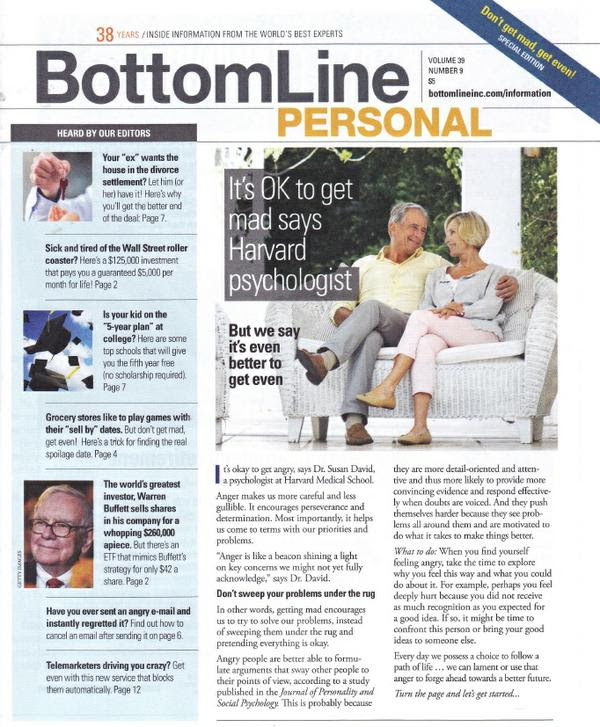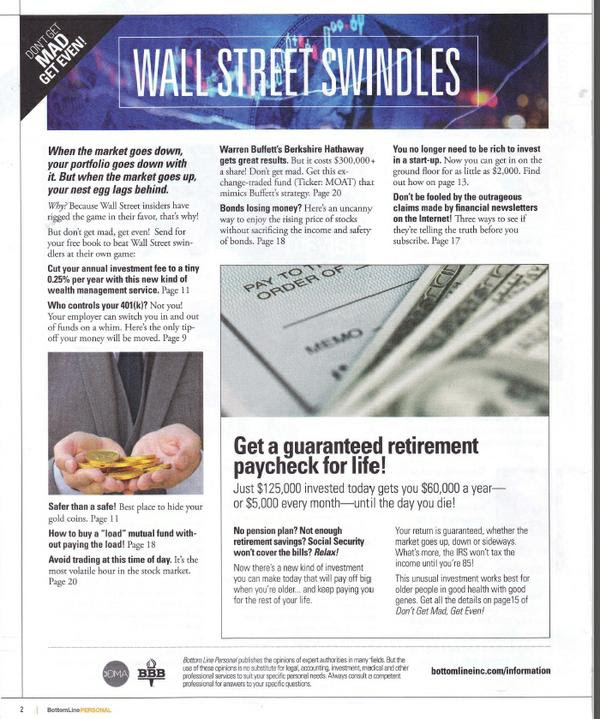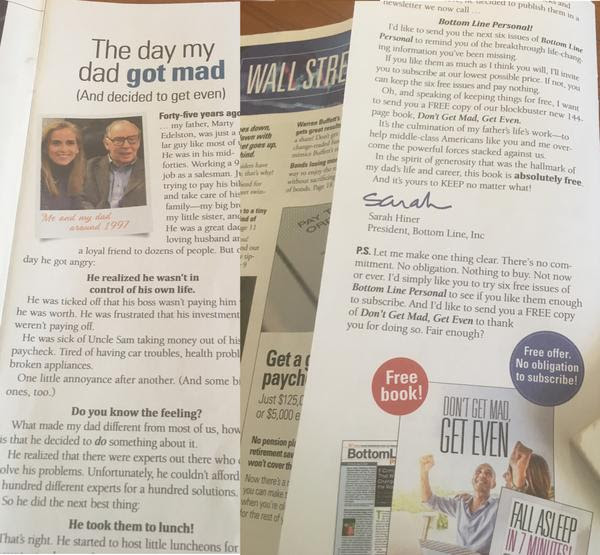Today I’m pulling this dripping-with-copywriting-gold issue out of the vault. It’s got some great things to share with you about writing ANY kind of copy.
Whether you write mostly short copy like emails or long-form copy like sales pages and VSLs, you’re going to discover some of my best-kept secrets for keeping your reader “hooked” on reading your ad or promo all the way through.
In fact, I’m going to use real-life examples from my OWN writing to show you what you want to avoid… and how to fix these common mistakes so you make your copy stronger. (Note that most of what I’ve seen Chat-GPT produce consistently violates all of these “rules”… hence the need for a savvy copywriter to intervene.)
Plus there’s a “What’s in Kim’s Mailbox” breakdown of a successful promo written by A-List copywriter Richard Armstrong, someone who’s been writing for the “big dogs” of direct response for even longer than me (and he’s one of your fellow Copy Insiders to boot!)
So grab a cuppa and settle in for some tips and tactics that will rock your world when it comes to crafting “un-put-downable” sales copy… the kind that makes it far more likely your prospects will buy from you…
Issue #53—January 25, 2019
Today’s issue is going to be on something you probably don’t hear about in copywriting books or many courses.
Here’s a hint: it has to do with good writing.
Now, you’ve probably heard you don’t need to be a good writer to be a good copywriter. You simply need to understand the techniques, your prospect, and how to sell.
Well, that’s BS–especially when it comes to writing long-form copy for direct mail, VSLs, or sales pages. None of which are “dead” yet BTW, despite premature “reports of their death” which, in Mark Twain’s own words, “have been greatly exaggerated”.
You can and should learn ALL the copywriting and selling techniques you possibly can–and make sure you know your prospect inside and out. But you also can learn some simple ways to improve your writing so you can produce more effective copy.
That’s because if someone gets lost or confused or tripped up when reading your copy, you’re going to lose them. And if you lose them, they’re never going to get to your fabulous offer or your excellent proof or your compelling testimonials.
So your copy will NOT be effective, since it will fail to close the sale.
Here’s a confession: I never took an English class in college (I did score pretty highly on verbal though). But there are a few things I’ve picked up about good writing as a freelance copywriter the past 20+ years.
As silky-smooth as smooth jazz
Once you’ve hooked them into reading with your email copy, headline, and/or lead, what do you want to keep your reader doing? Reading!
Everyone tells you the job of that first sentence is to get the next one read, and so forth. You pile on the benefits, intrigue, and proof to do just that.
But all too often, the menace of bad writing steps in–and knocks your prospect off course. They’re no longer sliding effortlessly down that “greased tube” that keeps them engaged and reading your copy.
You want your copy to be “smooth as silk”…easily digestible…without requiring a lot of work to keep up with or understand what you’re saying.
The headline and lead are crucial–but the body copy is where the great copy war is won or lost.
(I’m not sure that war analogy is working, but hey–I didn’t have any English classes in college!)
Today I want to share with you 4 common writing mistakes you can easily learn to recognize and fix in your copy. Focusing on these things after you’ve produced your draft can dramatically improve the effectiveness of your copy.
So without further ado, let’s get started with…
The four horsemen of bad writing

I’m going to explain these 4 common writing mistakes so you can avoid making them yourself. I’m even going to give you ACTUAL examples of me making these writing mistakes in early drafts of my copy many years ago (once I fixed them, all of these promos went on to become strong, long-running controls).
Horseman #1: Changing subjects within paragraphs–Yours truly has been guilty of this many times. After all, we know what we’re saying, right? But your prospect may have trouble following along when one sentence starts with something as the subject and then the next sentence has something else.
Here’s an example of this mistake from an early draft of a Pectasol supplement promotion I wrote:
Lead exposure can trigger joint stiffness, allergies, blood pressure concerns, reduced libido, weakened immune function, and much more. [Changing subjects]
Yet every time you brush your teeth, you ingest a little lead from an ingredient commonly found in toothpaste. [Changing subjects again] The newspaper ink that smudges your fingers often contains lead. [Changing subjects again] And you may drink a little lead every time you sip your daily coffee from a ceramic mug. It’s also in household dust, hair dyes, wine, and other products.
Reading this (way-too-long) paragraph, are you not totally confused? (Don’t worry, I fixed it before it the promo went out!) Now let’s look at another common mistake I often come across…
Horseman #2: The dreaded “it”–This harmless pronoun can deal out plenty of confusion. When you go from one paragraph to the next and start it with “It” or refer to “it”, your prospect may have forgotten what “it” is.
It’s much better to repeat that subject in your sentence in the next paragraph, or in a later sentence within that paragraph, so it’s always clear to your prospect what you’re referring to.
I had a hard time finding an example of this in my copy, but I see this mistake all the time when I review others’ copy. However, I did find this example from my long-running Integrative Digestive Formula control (which despite this mistake is still a control 11 years later):
Another popular digestive remedy you may have heard of is black pepper, which helps combat “acid” stomach. Known as Piper nigrum or piperine in traditional Chinese medicine, black pepper helps boost production of digestive enzymes.
It may also protect you from food poisoning. One study found black pepper contains compounds that kill off 25% of the bad bacteria found in food that causes spoilage.
Now, imagine if I had started that next paragraph with “Black pepper” instead of “It”, and than changed “black pepper” in the second sentence to “it”? There would have been more effortless gliding down that “greased tube” when transitioning between paragraphs.
Speaking of which, that leads me to the third horseman of bad writing…
Horseman #3:Awkward transitions within or between paragraphs–You can throw your prospect way off course if you jump from one idea within a paragraph to a whole other topic in the next sentence or paragraph.
Here’s an example of this “bad writing” mistake from an early draft of a successful promo I wrote for Advanced Memory Formula (this got fixed, of course, and it mailed for 8+ years as the control.)
That’s because making PS requires a substantial amount of energy. And since PS is found in only trace amounts in common foods, you don’t get much from your diet.
Take a look at what’s happening between “energy” at the end of the first sentence and “And” at the beginning of the second. It’s jumping from one subject and idea to another without any transition.
The reader may have expected to hear after the first sentence something like “As you get older, you don’t make as much energy”. But instead they’re jerked around to the next idea in the paragraph–the opposite of sliding down a “greased tube”.
Okay, let’s look at one more writing mistake that can kill your copy’s effectiveness…
Horseman #4: Writing long-as*ed sentences. Again, I’m guilty as charged! I always need to go back through my drafts and break these suckers down into multiple sentences.
When you combine too many different ideas in one sentence (just like if you do so for headlines), you dilute the power of what you are saying. You also risk confusing your prospect and creating an unnecessary “speed bump” on their greased-tube ride through your copy.
I’ve got many examples of what I call “LAS”‘s in my early drafts of copy, but here’s one from my first draft of that same Advanced Memory Formula promo…
What’s more, free radicals may also increase production of beta amyloid, which is toxic to neurons in the brain and causes amyloid plaques to form.
You can do many things with LAS’s. Often the best thing to do is to break those 2 or 3 different ideas within your one sentence into separate sentences. (This will also bring down your Fleisch-Kincaid score, which you want to be under 8th grade reading level at the very least.)
In the example above, you could say it this way instead:
What’s more, free radicals may also increase production of beta amyloid. Beta amyloid is toxic to neurons in the brain. It also causes amyloid plaques to form.
You can also separate different ideas/phrases within a long-as*ed sentence with…ellipses! (I use them a lot). Or you can break them up into a list of checkmarks or regular bullets, which also makes your copy more scannable and easy to read.
In any case, those are the “4 horsemen” of bad writing that can wreck your copy’s effectiveness. And there are more to watch out for, too, but maybe we’ll cover those in an upcoming issue.
For now, let’s take a look at a promotion that showed up in my mailbox right after the start of the New Year…
What’s in Kim’s Mailbox?
This “faux issue” magalog-sized promo is a new control for Bottom Line (the company formerly known as Boardroom). It’s for their flagship newsletter Bottom Line Personal and it was written by my friend and fellow copywriter, the great Richard Armstrong.
Here’s the front cover…

I have huge respect for Richard. He’s written (and is still writing) many blockbuster controls for the biggest direct marketing companies. Not only is he a legend in his own time, he’s also one of the nicest and most gentlemanly people you ever could meet.
To get this latest blockbuster control, Richard likely had to beat Parris Lampropoulus, who’s held the Bottom Line Personal control for years after beating Arthur Johnson’s formerly unbeatable control. So that’s no small feat!
Let’s look at a few things on the front cover. But first, look at the design look. It’s not meant to look like a promotion. It’s meant to look valuable. So it has a very editorial look, as if it’s an actual issue of the newsletter.
That means headlines and other copy may not be of the typical, benefit-blasting variety. Take a look at the headline and subhead Richard is using here:
It’s OK to get mad says Harvard psychologist
But we say it’s even better to get even
I’m not seeing a big blasted benefit here. I do see some relief from guilt (if you, like 100% of the population, have ever gotten mad).
I do see curiosity (not expecting to see “even better to get even” and that makes me want to find out more). And I see the credibility (“Harvard” psychologist”), which further piques my curiosity.
This is the kind of main headline for this style of promotion that can work well. Like I said, it’s not your traditional main headline. Same with the lead in the copy below it. It’s written very much like a news article. So it draws you in even if you initially have your guard up, thinking it’s just a selling piece.
And most important of all, it’s giving away value right away. In the second column of the lead article, it gives away some of the Harvard psychologist’s advice.
There’s an immediate benefit for reading this promotion, which makes it much more likely the prospect will continue. It’s also demonstrating the product before it’s even presented.
There’s also a great page-turner at the end to get the reader inside the promotion. The bullets in the faux “table of contents” left-hand sidebar do the same job. They’re oozing with curiosity and hitting a wide range of emotions.
More importantly, the bullets on the front cover demonstrate the product by showing a wide range of topics. (This is also to cast a wider net and present at least one that the prospect is particularly interested in and wants to find out more about.)
The only suggestion I have here is to add at least one bullet that’s related to health. Inside there’s a whole page about “Medical miseries” and health is one of the main topics covered by Bottom Line Personal…and a big draw in this market.
(This may have been done on purpose to differentiate from the company’s Bottom Line Health promotions, but I still feel one could have been included to expand its reach.)
You also get the idea that Richard really knows his audience here and who he’s writing to. You can see it both in the range of topics in the front cover bullets as well as throughout the different sections of this 16-page self-mailer. It’s likely someone who’s married, with young adult kids, in their 50s or 60s, possibly retired.
They care about things like their investments, paying for college, and everyday consumer issues. Thus, subsequent topics, each with very topical “headlines” at the top of each page that follows, include “Wall Street Swindles”, “Car Trouble”, “Retail Rip-offs”, “Tech Frustrations”, and “Travel Nightmares”, to name a few.
Here’s a look at page 2 of the promotion–many other pages are formatted and designed in a similar way…

I love how the “Don’t get mad, get even” corner callout in the upper left corner transitions the reader from the promise or hook in the main headline to the next page, so it seems connected and doesn’t feel too choppy.
This is all very strong copy. The fascinations are full of news, benefit, and curiosity. However, on this page–being the first one besides the front cover–it’s not clear to me what those page number references are for. Is this a “table of contents”? I turned to some of the pages in the promo and that turned out not to be the case (and there isn’t a page 17, 18 or 20 anyway).
In the sidebar I see mention of “Don’t Get Mad, Get Even!” but I don’t know what that is. Is it a book? A free report? It’s not clear.On page 3 (which I haven’t included here), there’s copy that says “send for your free copy of” the aforementioned thing (don’t know if it’s a report or book still…but seems like a book since the page numbers are now up over 100).
Just about every page of the promotion is like this…full of intriguing bullets and mini-articles, with tease about getting the details in “Don’t Get Mad, Get Even!”
Now, if you do read the brilliantly-done lift letter (it’s bound in between pages 2 and 3 and connected to an order card between pages 14 and 15), you know what’s going on. Here’s a peek (I merged two photos into one so it’s a little hard to follow:)

I love how the current president of the company, Sarah Hiner, tells a story (although we know it’s really Richard telling it) about her father, the late Marty Edelston. For those who don’t know, Marty was the founder of Boardroom and appeared in many promos. So many people still on their lists know who he was.
By telling this personal story, Sarah (Richard) is basically telling the brand story and introducing the product, Bottom Line Personal. On the back of the lift letter, you can see that the offer is being presented here as well.
Aside from a testimonial sidebar on page 8, no where else is “Bottom Line Personal” mentioned in the promo, except on the order card. It’s all about selling the premium–in this case the “Don’t Get Mad, Get Even” book, report, or whatever the heck it is.
And that’s the tried-and-true approach to selling any newsletter. In part this is because the newsletter is this ever-changing thing–so selling “what you’ll discover” is difficult if not impossible because we don’t know the future topics–or the future, either.
But we can sell the content that already exists today…and hopefully allow this to be an evergreen promo that mails for many years! Hope that’s the case for you, Richard, with this excellently-executed promotion. Congrats again!
That’s “it” for today’s issue (I say “it” because it’s a LOT!) Hope you gleaned some new insights out of it. Make sure you keep those “four horsemen” in mind ever time you write, edit, and review yours or someone else’s copy. Let’s keep our readers gliding through those “greased chutes”!
Yours for smarter marketing,
Kim
***
UPDATED P.S. If you want to discover my best A-list-level tactics for writing successful sales copy, my Get Dangerously Good Copywriting System is my “magnum opus” as far as showing you all my very best secrets I’ve gleaned over the last 25 years.
I’m getting ready to raise the price of this program, which I’ve drastically underpriced in terms of the value it delivers since I launched it in September.
But in the coming days you’ll have the chance to beat the coming price rise–and snag a super-valuable bonus when you do so. So you’ll want to stay tuned… and if you’re curious in checking out this potentially game-changing program in advance, you can do so here.